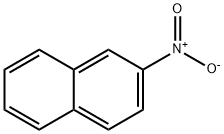2-NITRONAPHTHALENE
- CAS No.
- 581-89-5
- Chemical Name:
- 2-NITRONAPHTHALENE
- Synonyms
- 2-nitro-naphthalen;2-NITRONAPHTHALENE;beta-Nitronaphthalene;2-Nitronaphthalene (purity);C20965200 2-Nitronaphthalene;2-Nitronaphthalene,85%,tech.;2-Nitronaphthalene in Cyclohexane;60548, 2-Nitronaphthalene (purity)
- CBNumber:
- CB4737418
- Molecular Formula:
- C10H7NO2
- Molecular Weight:
- 173.17
- MDL Number:
- MFCD00004055
- MOL File:
- 581-89-5.mol
| Melting point | 65-73 °C |
|---|---|
| Boiling point | 303.81°C (rough estimate) |
| Density | 1.279±0.06 g/cm3 (20 ºC 760 Torr) |
| refractive index | 1.5200 (estimate) |
| storage temp. | 2-8°C |
| solubility | Acetonitrile (Slightly), Chloroform (Slightly) |
| BRN | 2046354 |
| EWG's Food Scores | 3 |
| FDA UNII | V5NB52B64Q |
| IARC | 3 (Vol. 46) 1989 |
| EPA Substance Registry System | 2-Nitronaphthalene (581-89-5) |
SAFETY
Risk and Safety Statements
| Symbol(GHS) |    GHS02,GHS08,GHS09 |
|||||||||
|---|---|---|---|---|---|---|---|---|---|---|
| Signal word | Danger | |||||||||
| Hazard statements | H228-H350-H411 | |||||||||
| Precautionary statements | P201-P210-P273-P308+P313 | |||||||||
| Hazard Codes | T,N,F | |||||||||
| Risk Statements | 45-51/53-11 | |||||||||
| Safety Statements | 53-45-61-60 | |||||||||
| RIDADR | 2538 | |||||||||
| WGK Germany | 3 | |||||||||
| RTECS | QJ9760000 | |||||||||
| HazardClass | 4.1 | |||||||||
| PackingGroup | III | |||||||||
| HS Code | 2904200090 | |||||||||
| NFPA 704 |
|
2-NITRONAPHTHALENE Chemical Properties,Uses,Production
Chemical Properties
yellow to brown crystalline powder or chunks
Definition
ChEBI: A mononitronaphthalene carrying a nitro group at position 2.
Synthesis Reference(s)
Journal of the American Chemical Society, 76, p. 6144, 1954 DOI: 10.1021/ja01652a083
General Description
Yellow crystalline solid. Mp: 76°C; bp: 315°C. Insoluble in water. Very soluble in ethyl alcohol and in diethyl ether. Toxic to aquatic organisms, may cause long-term adverse effects in the environment.
Reactivity Profile
2-NITRONAPHTHALENE is non-flammable but combustible (flash point 160°C). Dust forms explosive mixtures with air. Heating or burning releases toxic and corrosive gases. Incompatible with strong oxidizing agents. Can serve as an oxidizing agent and so react with reducing agents such as hydrides, sulfides and nitrides. Such reactions may be vigorous and may culminate in a detonation. May explode in the presence of strong bases such as sodium or potassium hydroxide even in the presence of water or organic solvents.
Safety Profile
Confirmed carcinogen with experimental tumorigenic data. Moderately toxic by ingestion and intraperitoneal routes. Mutation data reported. A sktn and lung irritant. For explosion and disaster hazards, see NITRATES. Combustible when exposed to heat or flame. When heated to decomposition it emits toxic fumes of NOx. See also 1-NITRONAPHTHALENE.
Purification Methods
Distil it in a vacuum and/or crystallise it from aqueous EtOH and sublime in a vacuum. The 1:1 1,3,5-trinitrobenzene complex has m 75.5o (from EtOH). [Beilstein 5 H 555, 5 III 1596, 5 IV 1675.]





